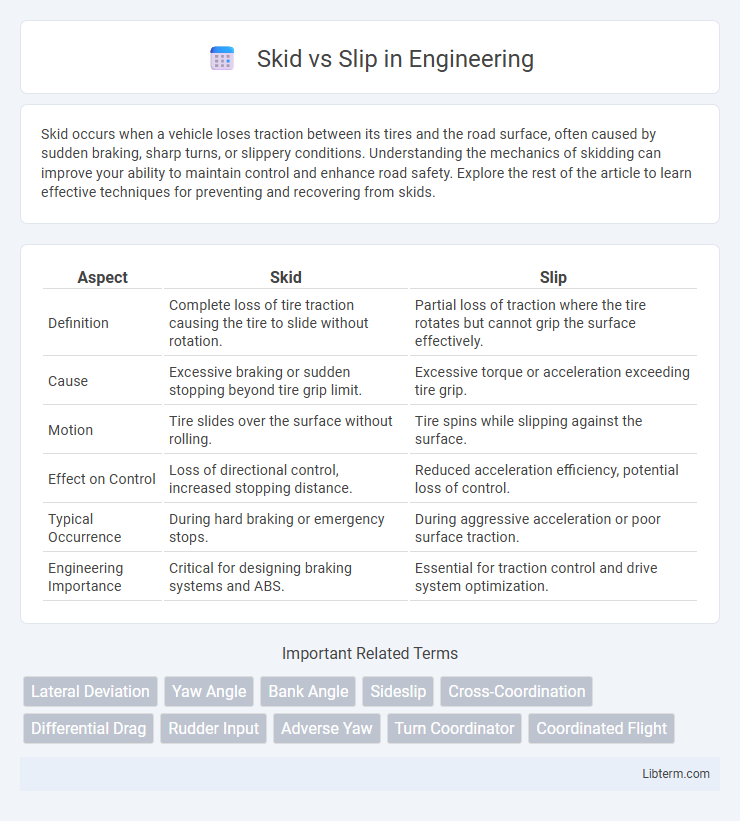Skid occurs when a vehicle loses traction between its tires and the road surface, often caused by sudden braking, sharp turns, or slippery conditions. Understanding the mechanics of skidding can improve your ability to maintain control and enhance road safety. Explore the rest of the article to learn effective techniques for preventing and recovering from skids.
Table of Comparison
| Aspect | Skid | Slip |
|---|---|---|
| Definition | Complete loss of tire traction causing the tire to slide without rotation. | Partial loss of traction where the tire rotates but cannot grip the surface effectively. |
| Cause | Excessive braking or sudden stopping beyond tire grip limit. | Excessive torque or acceleration exceeding tire grip. |
| Motion | Tire slides over the surface without rolling. | Tire spins while slipping against the surface. |
| Effect on Control | Loss of directional control, increased stopping distance. | Reduced acceleration efficiency, potential loss of control. |
| Typical Occurrence | During hard braking or emergency stops. | During aggressive acceleration or poor surface traction. |
| Engineering Importance | Critical for designing braking systems and ABS. | Essential for traction control and drive system optimization. |
Understanding the Concepts: Skid vs Slip
Skid and slip represent distinct conditions affecting vehicle tires and traction. Skid occurs when tires lose traction due to excessive braking or acceleration, causing the vehicle to slide uncontrollably on the surface. Slip refers to the difference between the tires' rotational speed and the vehicle's actual speed, affecting grip and stability during cornering or acceleration.
Key Differences Between Skid and Slip
Skid refers to the loss of traction between a vehicle's tires and the road surface, causing the tires to slide without rotating, while slip indicates the relative motion between the tire tread and the road due to insufficient friction. A key difference lies in their mechanics; skid occurs when tires lock up and cease rolling, often during abrupt braking, whereas slip involves controlled or partial loss of grip, such as during acceleration or cornering. Understanding these distinctions is crucial for vehicle dynamics, influencing safety systems like anti-lock braking systems (ABS) and traction control systems (TCS) designed to manage skid and slip, respectively.
Causes of Skidding in Vehicles
Skidding in vehicles primarily occurs due to sudden braking, sharp turns, or acceleration on slippery surfaces such as wet, icy, or loose gravel roads. Loss of tire traction results from factors like worn-out tires, uneven road conditions, or debris that reduce friction between tires and the roadway. Inadequate vehicle control, combined with adverse weather conditions, significantly increases the likelihood of skidding incidents.
Factors Leading to Slipping
Slipping primarily occurs due to inadequate friction between the footwear and the walking surface, often caused by contaminants like water, oil, or loose debris. The surface texture and material type significantly influence the slip resistance, with smooth or polished floors increasing the risk. Proper footwear with slip-resistant soles and maintaining clean, dry floors are critical factors in preventing slip incidents.
Physics Behind Skid and Slip
Skid and slip both involve the loss of traction between a tire and the surface, but differ in the physics behind them. Skid occurs when a tire slides without rotating, resulting in kinetic friction dominating over static friction, causing a sudden loss of grip. Slip refers to the difference between the tire's rotational speed and the actual speed of the vehicle, where partial grip allows controlled movement but involves continuous frictional forces adjusting to maintain motion.
Real-World Examples of Skid and Slip
Skid refers to the loss of traction between a vehicle's tires and the road surface, often occurring during hard braking or sharp turns, exemplified by a car locking its wheels on wet pavement and sliding uncontrollably. Slip occurs when there is relative motion between a vehicle's tires and the driving surface but traction is still partially maintained, such as a motorcycle's rear wheel spinning slightly on gravel while accelerating. Real-world examples include emergency braking in a rainstorm causing a skid, and a cyclist's tires slipping on loose dirt where some grip remains to slow sliding.
Safety Implications of Skid and Slip
Skid and slip incidents pose significant safety risks by increasing the likelihood of falls, injuries, and accidents in workplaces and public areas. Skid occurs when tires or shoes lose traction against a surface, often leading to uncontrolled movement and potential collisions, whereas slip happens due to insufficient friction between footwear and walking surfaces, causing sudden loss of balance. Proper hazard identification, use of anti-slip materials, and regular maintenance are essential to mitigate these risks and enhance overall safety.
Prevention Techniques for Skidding
Skidding occurs when tires lose traction, often due to sudden braking or sharp turns on slippery surfaces, increasing the risk of accidents. Prevention techniques for skidding include maintaining proper tire pressure, using anti-lock braking systems (ABS), and driving at reduced speeds in adverse weather conditions such as rain, snow, or ice. Ensuring regular tire maintenance and practicing smooth steering inputs are essential to enhance traction and avoid loss of vehicle control.
Minimizing Slip: Practical Solutions
Minimizing slip involves improving surface traction through anti-slip coatings, textured flooring, and rubber mats that increase grip. Implementing proper footwear with slip-resistant soles and maintaining clean, dry surfaces significantly reduce slip risks. Regular inspections and prompt spill cleanups also enhance safety by preventing slippery conditions in high-traffic areas.
Skid and Slip in Industrial Applications
Skid and slip are critical factors in industrial applications affecting equipment safety and operational efficiency. Skid occurs when a wheel or surface abruptly loses traction, causing uncontrolled movement or stops, often leading to machinery damage or workplace accidents. Slip involves a gradual loss of grip, posing risks in conveyor systems, material handling, and industrial vehicles by reducing control and increasing wear on components.
Skid Infographic

 libterm.com
libterm.com